Attached files
| file | filename |
|---|---|
| S-1/A - FORM S-1/A - Petron Energy II, Inc. | peii020314forms1a.htm |
| EX-23.1 - EXHIBIT 23.1 - Petron Energy II, Inc. | peii020314forms1aex23_1.htm |
FORREST A. GARB & ASSOCIATES, INC.
INTERNATIONAL PETROLEUM CONSULTANTS
5310 HARVEST HILL ROAD, SUITE 275, LB 152
DALLAS, TEXAS 75230 • 5805
(972)788-1110 Telefax (972)991-3160 (EMAIL) forgarb@forgarb.com
February 20, 2013
Mr. Floyd Smith
Petron Energy II, Inc.
12850 Preston Road, Suite 960
Dallas, TX 75252
Dear Mr. Smith:
At your request, Forrest A. Garb & Associates, Inc. (FGA) has estimated the proved and probable reserves and future net revenue, as of January 1, 2013, attributable to interests owned by Petron Energy II, Inc. (Petron) in certain oil and gas properties located in Oklahoma and Texas. It is our understanding that the reserves in this report constitute 100 percent of the reserves owned by Petron.
This report has been prepared using the definitions and guidelines of the U.S. Securities and Exchange Commission (SEC), and with the exception of the exclusion of future income taxes, conforms to the FASB Accounting Standards Codification Topic 932, Extractive Industries- Oil and Gas. These guidelines specify the use of a 12-month first-day-of-the-month average benchmark price, a ten percent discount factor, and constant oil and gas prices and costs.
The following table summarizes the estimated total net reserves and future net revenue, as of January 1, 2013:

ENGINEERING
Proved oil and gas reserves are those quantities of oil and gas which, by analysis of engineering and geoscience data, can be estimated with reasonable certainty to be economically producible from a given date forward. The basis for estimating the proved producing reserves was the extrapolation of historical production having an established decline trend. Volumetrics and/or analogy were used for forecasting properties where insufficient data were present for production decline extrapolation. Production histories were obtained from published production data and state reporting records purchased from a third party provider, HPDI, LLC, and supplemented with data provided by Petron. The reserves for other reserve categories were estimated by analogy to adjacent comparable wells. Petron provided the available geologic and engineering data for FGA's review. FGA has accepted Petron's intent to recomplete the proved developed non-producing property and to drill the probable locations. Probable reserves are those additional reserves that are less certain to be recovered than proved reserves but which, together with proved reserves, are as likely as not to be recovered.
The analysis and findings presented in this report, represent FGA's informed judgments based on accepted standards of professional engineering practice, but are subject to the generally recognized and unforeseen risks associated with the interpretation of geological, geophysical, and engineering data. Estimates of reserves were prepared by the use of appropriate geologic, petroleum engineering, and evaluation principles and techniques which are in accordance with practices generally recognized by the petroleum industry. Future changes in federal, state, or local regulations may adversely impact the ability to recover the future oil and gas volumes expected. Changes in economic and market conditions from the assumptions and parameters used in this study may cause the total quantity of future oil or gas recovered, actual production rates, prices received, operating expenses and capital costs to vary from the results presented in this report.
Gas volumes are expressed in millions of cubic feet (MMcf) at standard temperature and pressure. Gas sales imbalances have not been taken into account in the reserve estimates. The oil reserves shown in this study include crude oil and/or condensate. Oil volumes are expressed in thousands of barrels (MBbl), with one barrel equivalent to 42 United States gallons.
ECONOMIC CONSIDERATIONS
The benchmark oil and gas prices used in this study are the average of the first day of the month spot prices posted for the West Texas Intermediate (WTI) oil and Henry Hub natural gas, per SEC guidelines. Oil prices are based on a benchmark price of $94.68 per barrel and have been adjusted by lease for gravity, transportation fees, and regional price differentials. Gas prices per thousand cubic feet (MCF) are based on a benchmark price of $2.76 per million British thermal units (MMBtu) and have been adjusted by lease for Btu content, transportation fees, and regional price differentials. The oil and gas prices are held constant for the economic life of the properties as specified by the SEC.
Lease operating costs and capital expenditures, as required for workovers, future development of new wells, and for production equipment, were provided by Petron for FGA's review. All costs have been held constant in this evaluation. Existing or potential liabilities stemming from environmental conditions caused by current or past operating practices have not been considered in this report. No costs are included in the projections of future net revenue or in our economic analyses to restore, repair, or improve the environmental conditions of the properties studied to meet existing or future local, state, or federal regulations.
Grand total summary economic projections by reserve category and category summaries (including one-line summaries for the individual properties) are presented in Attachment A.
Attachment B presents the definitions of proved oil and gas reserves in accordance with the SEC. General comments regarding this report and the estimation of future reserves and revenue are presented in Attachment C. Attachment D contains the consulting firm profile.
The estimated future net revenues shown are those which should be realized from the sale of estimated oil and gas reserves after the deduction of severance taxes, ad valorem taxes, direct operating costs, and future capital expenditures. No deductions have been made for overhead, federal income taxes, or other indirect costs, such as interest expense and loan repayments. Surface and well equipment salvage values have not been considered in the revenue projections. The estimated reserves included in the cash flow projections have not been adjusted for risk. The reserves included in this study are estimates only and should not be construed as exact quantities. Future conditions may affect recovery of estimated reserves and revenue, and all categories of reserves may be subject to revision as more performance data become available.
Petron provided ownership interests in the properties, and FGA accepted the extent and character of ownership (working interest and net revenue interest) as represented. Our staff conducted no independent well tests, property inspections, or audits of completion and operating expenses as part of this study.
FGA is an independent firm of geologists and petroleum engineers. Neither the firm nor its employees own any interest in the properties studied, nor have we been employed on a contingency basis. FGA has used all necessary methods and procedures in the preparation of this report for the evaluation of these properties.
We appreciate the opportunity to submit this evaluation. Should you have any questions, please do not hesitate to call.
This report was prepared under the supervision of W.D. Harris III, Registered
Professional Engineer No. 75222, State of Texas.
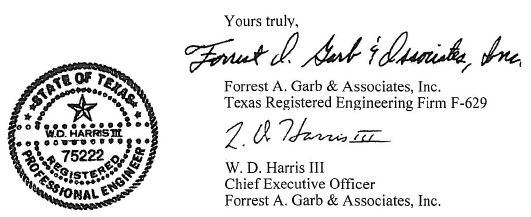
ATTACHMENTS
A. CATEGORY AND ONE-LINE SUMMARIES
B. DEFINITIONS FOR OIL AND GAS RESERVES
C. GENERAL COMMENTS
D. CONSULTING FIRM PROFILE
ATTACHMENT A
CATEGORY AND ONE-LINE SUMMARIES
PROVED
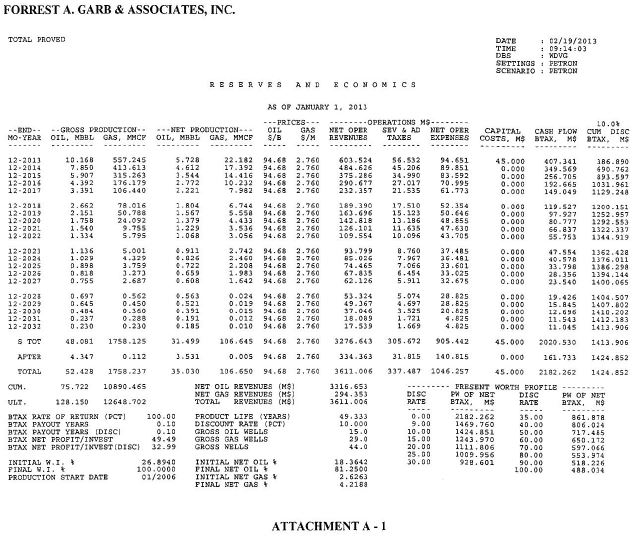
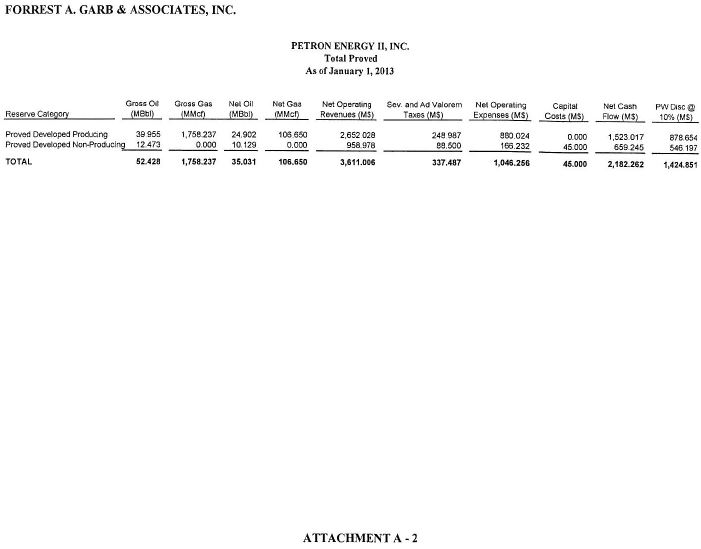
FORREST A. HARB & ASSOCIATES, INC.
PROVED DEVELOPED PRODUCING
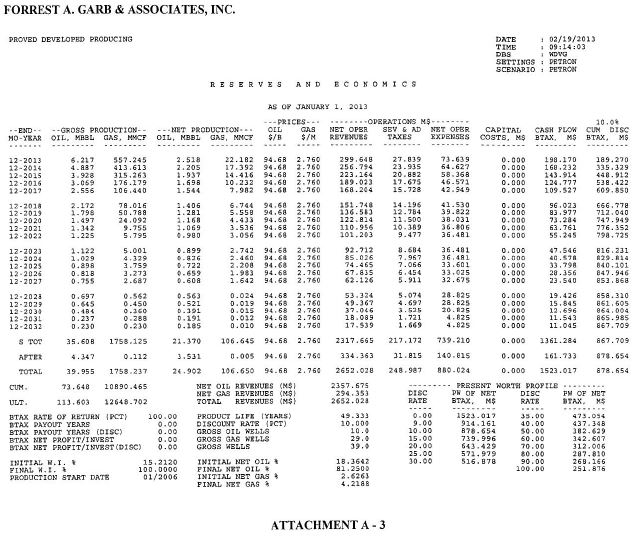
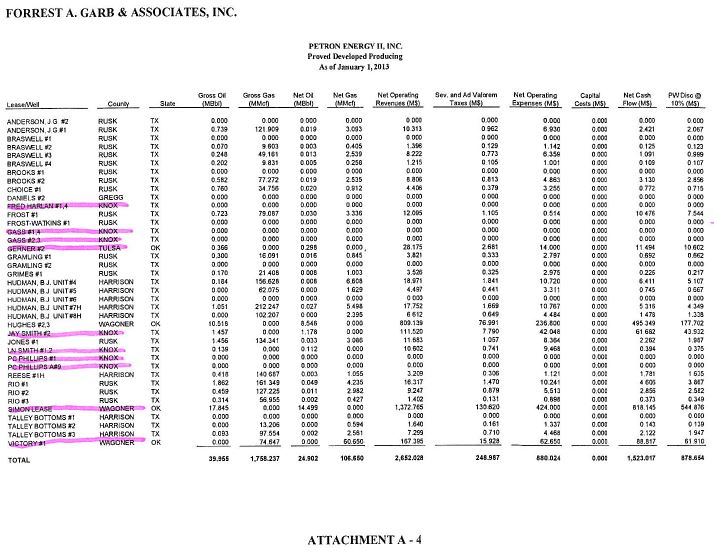
FORREST A. GARB & ASSOCIATES, INC.
PROVED DEVELOPED NON-PRODUCING
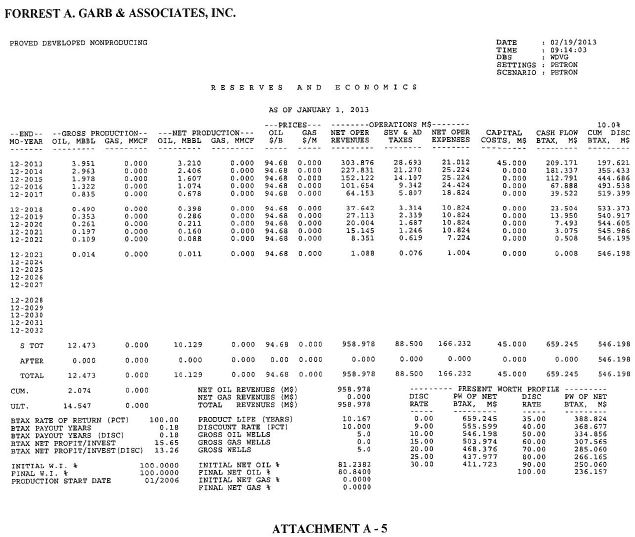

FORREST A . GARB & ASSOCIATES, INC.
PROBABLE
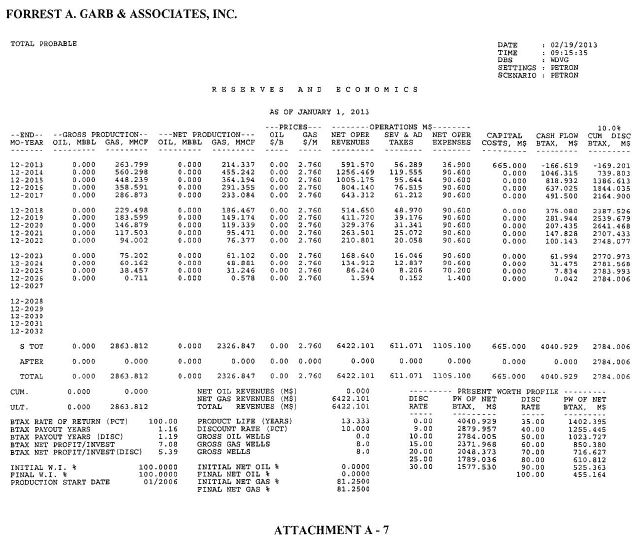
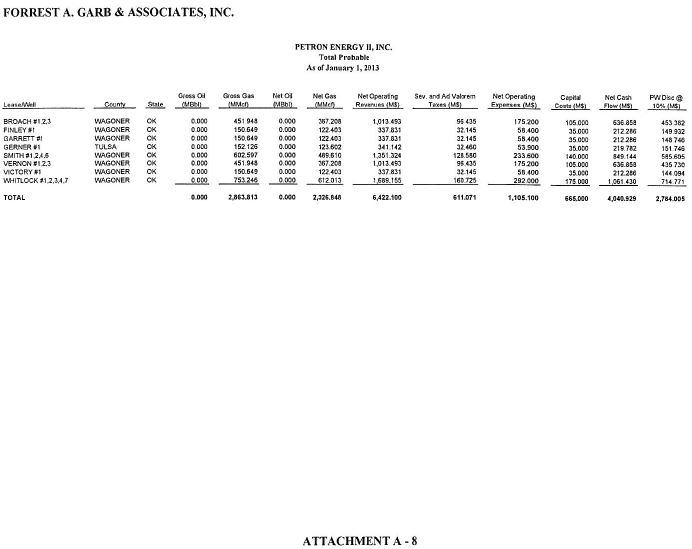
FORREST A. GARB & ASSOCIATES, INC.
ATTACHMENT B
DEFINITIONS FOR OIL AND GAS RESERVES
DEFINITIONS FOR OIL AND GAS RESERVES*
(I) Acquisition of properties. Costs incurred to purchase, lease or otherwise acquire a property, including costs of lease bonuses and options to purchase or lease properties, the portion of costs applicable to minerals when land including mineral rights is purchased in fee, brokers' fees, recording fees, legal costs, and other costs incurred in acquiring properties.
(2) Analogous reservoir. Analogous reservoirs, as used in resources assessments, have similar rock and fluid properties, reservoir conditions (depth, temperature, and pressure) and drive mechanisms, but are typically at a more advanced stage of development than the reservoir of interest and thus may provide concepts to assist in the interpretation of more limited data and estimation of recovery. When used to support proved reserves, an "analogous reservoir" refers to a reservoir that shares the following characteristics with the reservoir of interest:
(i) Same geological formation (but not necessarily in press ure communication with the reservoir of interest);
(ii) Same environment of deposition;
(iii) Similar geological structure; and
(iv) Same drive mechanism.
(3) Bitumen. Bitumen, sometimes referred to as natural bitumen, is petroleum in a solid or semi solid state in natural deposits with a viscosity greater than 10,000 centipoise measured at original temperature in the deposit and atmospheric pressure, on a gas free basis. In its natural state it usually contains sulfur, metals, and other non-hydrocarbons.
(4) Condensate. Condensate is a mixture of hydrocarbons that exists in the gaseous phase at original reservoir temperature and pressure, but that, when produced, is in the liquid phase at surface pressure and temperature.
(5) Deterministic estimate. The method of estimating reserves or resources is called detenninistic when a single value for each parameter (from the geoscience, engineering, or economic data) in the reserves calculation is used in the reserves estimation procedure.
(6) Developed oil and gas reserves. Developed oil and gas reserves are reserves of any category that can be expected to be recovered:
(i) Through existing wells with existing equipment and operating methods or in which the cost of the required equipment is relatively minor compared to the cost of a new well; and
(ii) Through installed extraction equipment and infrastructure operational at the time of the reserves estimate if the extraction is by means not involving a well.
*These Reserves Definitions are those included i n the Securities and Exchange Commission Regulation S-X as of January 1, 2010.
(7) Development costs. Costs incurred to obtain access to proved reserves and to provide facilities for extracting, treating, gathering and storing the oil and gas. More specifically, development costs, including depreciation and applicable operating costs of support equipment and facilities and other costs of development activities, are costs incurred to:
(i) Gain access to and prepare well locations for drilling, including surveying well locations for the purpose of determining specific development drilling sites, clearing ground, draining, road building, and relocating public roads, gas lines, and power lines, to the extent necessary in developing the proved reserves.
(ii) Drill and equip development wells, development-type stratigraphic test wells, and service wells, including the costs of platforms and of well equipment such as casing, tubing, pumping equipment, and the wellhead assembly.
(iii) Acquire, construct, and install production facilities such as lease flow lines, separators, treaters, heaters, manifolds, measuring devices, and production storage tanks, natural gas cycling and processing plants, and central utility and waste disposal systems.
(iv) Provide improved recovery systems.
(8) Development project. A development project is the means by which petroleum resources are brought to the status of economically producible. As examples, the development of a single reservoir or field, an incremental development in a producing field, or the integrated development of a group of several fields and associated facilities with a common ownership may constitute a development project.
(9) Development well. A well drilled within the proved area of an oil or gas reservoir to the depth of a stratigraphic horizon known to be productive.
(10) Economically producible. The term economically producible, as it relates to a resource, means a resource which generates revenue that exceeds, or is reasonably expected to exceed, the costs of the operation. The value of the products that generate revenue shall be determined at the terminal point of oil and gas producing activities as defined in paragraph (a)(16) of this section.
(11) Estimated ultimate recovery (EUR). Estimated ultimate recovery is the sum of reserves remaining as of a given date and cumulative production as of that date.
(12) Exploration costs. Costs incurred in identifying areas that may warrant examination and in examining specific areas that are considered to have prospects of containing oil and gas reserves, including costs of drilling exploratory wells and exploratory-type stratigraphic test wells. Exploration costs may be incurred both before acquiring the related property (sometimes referred to in part as prospecting costs) and after acquiring the property. Principal types of exploration costs, which include depreciation and applicable operating costs of support equipment and facilities and other costs of exploration activities, are:
(i) Costs of topographical, geographical and geophysical studies, rights of access to properties to conduct those studies, and salaries and other expenses of geologists, geophysical crews, and others conducting those studies. Collectively, these are sometimes referred to as geological and geophysical or G&G costs.
(ii) Costs of carrying and retaining undeveloped properties, such as delay rentals, ad valorem taxes on properties, legal costs for title defense, and the maintenance of land and lease records.
(iii) Dry hole contributions and bottom hole contributions.
(iv) Costs of drilling and equipping exploratory wells.
(v) Costs of drilling exploratory-type stratigraphic test wells.
(13) Exploratory well. An exploratory well is a well drilled to find a new field or to find a new reservoir in a field previously found to be productive of oil or gas in another reservoir. Generally, an exploratory well is any well that is not a development well, an extension well, a service well, or a stratigraphic test well as those items are defined in this section.
(14) Extension well. An extension well is a well drilled to extend the limits of a known reservoir.
(15) Field. An area consisting of a single reservoir or multiple reservoirs all grouped on or related to the same individual geological structural feature and/or stratigraphic condition. There may be two or more reservoirs in a field that are separated vertically by intervening impervious, strata, or laterally by local geologic barriers, or by both. Reservoirs that are associated by being in overlapping or adjacent fields may be treated as a single or common operational field. The geological terms structural feature and stratigraphic condition are intended to identify localized geological features as opposed to the broader terms of basins, trends, provinces, plays, areas-of interest, etc.
(16) Oil and gas producing activities. (i) Oil and gas producing activities include:
(A) The search for crude oil, incl uding condensate and natural gas liquids, or natural gas
("oil and gas") in their natural states and original locations;
(B) The acquisition of property rights or properties for the purpose of further exploration or for the purpose of removing the oil or gas from such properties;
(C) The construction, drilling, and production activ ities necessary to retrieve oil and gas from their natural reservoirs, including the acquisition, construction, installation, and maintenance of field gathering and storage systems, such as:
(1) Lifting the oil and gas to the surface; and
(2) Gathering, treating, and field processing (as in the case of processing gas to extract liquid hydrocarbons); and
(D) Extraction of saleable hydrocarbons, in the solid, liquid, or gaseous state, from oil sands, shale, coalbeds, or other nonrenewable natural resources which are intended to be upgraded into synthetic oil or gas, and activities undertaken with a view to such extraction.
(17) Possible reserves. Possible reserves are those additional reserves that are less certain to be recovered than probable reserves.
(i) When deterministic methods are used, the total quantities ultimately recovered from a project have a low probability of exceeding proved plus probable plus possible reserves. When probabilistic methods are used, there should be at least a 10% probability that the total quantities ultimately recovered will equal or exceed the proved plus probable plus possible reserves estimates.
(ii) Possible reserves may be assigned to areas of a reservoir adjacent to probable reserves where data control and interpretations of available data are progressively less certain. Frequently, this will be in areas where geoscience and engineering data are unable to define clearly the area and vertical limits of commercial production from the reservoir by a defined project.
(iii) Possible reserves also include incremental quantities associated with a greater percentage recovery of the hydrocarbons in place than the recovery quantities assumed for probable reserves.
(iv) The proved plus probable and proved plus probable plus possible reserves estimates must be based on reasonable alternative technical and commercial interpretations within the reservoir or subject project that are clearly documented, including comparisons to results in successful similar projects.
(v) Possible reserves may be assigned where geoscience and engineering data identify directly adjacent portions of a reservoir within the same accumulation that may be separated from proved areas by faults with displacement less than formation thickness or other geological discontinuities and that have not been penetrated by a wellbore, and the registrant believes that such adjacent portions are in communication with the known (proved) reservoir. Possible reserves may be assigned to areas that are structurally higher or lower than the proved area if these areas are in communication with the proved reservoir.
(vi) Pursuant to paragraph (a)(22)(iii) of this section, where direct observation has defined a highest known oil (HKO) elevation and the potential exists for an associated gas cap, proved oil reserves should be assigned in the structurally higher portions ofthe reservoir above the HKO only if the higher contact can be established with reasonable certainty through reliable technology. Portions of the reservoir that do not meet this reasonable certainty criterion may be assigned as probable and possible oil or gas based on reservoir fluid properties and pressure gradient interpretations.
(18) Probable reserves. Probable reserves are those additional reserves that are less certain to be recovered than proved reserves but which, together with proved reserves, are as likely as not to be recovered.
(i) When deterministic methods are used, it is as likely as not that actual remaining quantities recovered will exceed the sum of estimated proved plus probable reserves. When probabilistic methods are used, there should be at least a 50% probability that the actual quantities recovered will equal or exceed the proved plus probable reserves estimates.
(ii) Probable reserves may be assigned to areas of a reservoir adjacent to proved reserves where data control or interpretations of available data are less certain, even if the interpreted reservoir continuity of structure or productivity does not meet the reasonable certainty criterion. Probable reserves may be assigned to areas that are structurally higher than the proved area if these areas are in communication with the proved reservoir.
(iii) Probable reserves estimates also include potential incremental quantities associated with a greater percentage recovery of the hydrocarbons in place than assumed for proved reserves.
(iv) See also guidelines in paragraphs (a)( 17)(iv) and (a)(17)(vi) of this section.
(19) Probabilistic estimate. The method of estimation of reserves or resources is called probabilistic when the full range of values that could reasonably occur for each unknown parameter (from the geoscience and engineering data) is used to generate a full range of possible outcomes and their associated probabilities of occurrence.
(20) Production costs. (i) Costs incurred to operate and maintain wells and related equipment and facilities, including depreciation and applicable operating costs of support equipment and facilities and other costs of operating and maintaining those wells and related equipment and facilities. They become part of the cost of oil and gas produced. Examples of production costs (sometimes called lifting costs) are:
(A) Costs oflabor to operate the wells and related equipment and facilities.
(B) Repairs and maintenance.
(C) Materials, supplies, and fuel consumed and supplies utilized in operating the wells and related equipment and facilities.
(D) Property taxes and insurance applicable to proved properties and wells and related equipment and facilities.
(E) Severance taxes.
(ii) Some support equipment or facilities may serve two or more oil and gas producing activities and may also serve transportation, refining, and marketing activities. To the extent that the support equipment and facilities are used in oil and gas producing activities, their depreciation and applicable operating costs become exploration, development or production costs, as appropriate. Depreciation, depletion, and amortization of capitalized acquisition, exploration, and development costs are not production costs but also become part ofthe cost of oil and gas produced along with production (lifting) costs identified above.
(21) Proved area. The part of a property to which proved reserves have been specifically attributed.
(22) Proved oil and gas reserves. Proved oil and gas reserves are those quantities of oil and gas, which, by analysis of geoscience and engineering data, can be estimated with reasonable certainty to be economically producible-from a given date forward, from known reservoirs, and under existing economic conditions, operating methods, and government regulations-prior to the time at which contracts providing the right to operate expire, unless evidence indicates that renewal is reasonably certain, regardless of whether deterministic or probabilistic methods are used for the estimation. The project to extract the hydrocarbons must have commenced or the operator must
be reasonably certain that it will commence the project within a reasonable time.
(i) The area of the reservoir considered as proved includes:
(A) The area identified by drilling and limited by fluid contacts, if any, and
(B) Adjacent undrilled portions of the reservoir that can, with reasonable certainty, be judged to be continuous with it and to contain economically producible oil or gas on the basis of available geoscience and engineering data.
(ii) In the absence of data on fluid contacts, proved quantities in a reservoir are limited by the lowest known hydrocarbons (LKH) as seen in a well penetration unless geoscience, engineering, or performance data and reliable technology establishes a lower contact with reasonable certainty.
(iii) Where direct observation from well penetrations has defined a highest known oil (HKO) elevation and the potential exists for an associated gas cap, proved oil reserves may be assigned in the structurally higher portions of the reservoir only if geoscience, engineering, or performance data and reliable technology establish the higher contact with reasonable certainty.
(iv) Reserves which can be produced economically through application of improved recovery techniques (including, but not limited to, fluid injection) are included in the proved classification when:
(A) Successful testing by a pilot project in an area of the reservoir with properties no more favorable than in the reservoir as a whole, the operation of an installed program in the reservoir or an analogous reservoir, or other evidence using reliable technology establishes the reasonable certainty of the engineering analysis on which the project or program was based; and
(B) The project has been approved for development by all necessary parties and entities, including governmental entities.
(v) Existing economic conditions include prices and costs at which economic producibility from a reservoir is to be determined. The price shall be the average price during the 12-month period prior to the ending date of the period covered by the report, determined as an unweighted arithmetic average of the first-day-of-the-month price for each month within such period, unless prices are defined by contractual arrangements, excluding escalations based upon future conditions.
(23) Proved properties. Properties with proved reserves.
(24) Reasonable certainty. If deterministic methods are used, reasonable certainty means a high degree of confidence that the quantities will be recovered, If probabilistic methods are used, there should be at least a 90% probability that the quantities actually recovered will equal or exceed the estimate. A high degree of confidence exists if the quantity is much more likely to be achieved than not, and, as changes due to increased availability of geoscience (geological, geophysical, and geochemical), engineering, and economic data are made to estimated ultimate recovery (EUR) with time, reasonably certain EUR is much more likely to increase or remain constant than to decrease.
(25) Reliable technology. Reliable technology is a grouping of one or more technologies (including computational methods) that has been field tested and has been demonstrated to provide reasonably certain results with consistency and repeatability in the formation being evaluated or in an analogous formation.
(26) Reserves. Reserves are estimated remaining quantities of oil and gas and related substances anticipated to be economically producible, as of a given date, by application of development projects to known accumulations. In addition, there must exist, or there must be a reasonable expectation that there will exist, the legal right to produce or a revenue interest in the production, installed means of delivering oil and gas or related substances to market, and all permits and financing required to implement the project.
Note to paragraph (a)(26): Reserves should not be assigned to adjacent reservoirs isolated by major, potentially sealing, faults until those reservoirs are penetrated and evaluated as economically producible. Reserves should not be assigned to areas that are clearly separated from a known accumulation by a non-productive reservoir (i.e. , absence of reservoir, structurally low reservoir, or negative test results). Such areas may contain prospective resources (i.e. ,
potentially recoverable resources from undiscovered accumulations).
(27) Reservoir. A porous and permeable underground formation containing a natural accumulation of producible oil and/or gas that is confined by impermeable rock or water barriers and is individual and separate from other reservoirs.
(28) Resources. Resources are quantities of oil and gas estimated to exist in naturally occurring accumulations. A portion of the resources may be estimated to be recoverable, and another portion may be considered to be unrecoverable. Resources include both discovered and undiscovered accumulations.
(29) Service well. A well drilled or completed for the purpose of supporting production in an existing field. Specific purposes of service wells include gas injection, water injection, steam injection, air injection, salt-water disposal, water supply for injection, observation, or injection for in-situ combustion.
(30) Stratigraphic test well. A stratigraphic test well is a drilling effort, geologically directed, to obtain information pertaining to a specific geologic condition. Such wells customarily are drilled without the intent of being completed for hydrocarbon production. The classification also includes tests identified as core tests and all types of expendable holes related to hydrocarbon exploration. Stratigraphic tests are classified as "exploratory type" if not drilled in a known area or "development type" if drilled in a known area.
(31) Undeveloped oil and gas reserves. Undeveloped oil and gas reserves are reserves of any category that are expected to be recovered from new wells on undrilled acreage, or from existing wells where a relatively major expenditure is required for recompletion.
(i) Reserves on undrilled acreage shall be limited to those directly offsetting development spacing areas that are reasonably certain of production when drilled, unless evidence
using reliable technology exists that establishes reasonable certainty of economic producibility at greater distances.
(ii) Undrilled locations can be classified as having undeveloped reserves only if a development plan has been adopted indicating that they are scheduled to be drilled within five years, unless the specific circumstances, justify a longer time.
(iii) Under no circumstances shall estimates for undeveloped reserves be attributable to any acreage for which an application of fluid injection or other improved recovery technique is contemplated, unless such techniques have been proved effective by actual projects in the same reservoir or an analogous reservoir, as defined in paragraph (a)(2) of this section, or by other evidence using reliable technology establishing reasonable certainty.
(32) Unproved properties. Properties with no proved reserves.
FORREST A. GARB & ASSOCIATES, INC.
ATTACHMENT C
GENERAL COMMENTS
GENERAL COMMENTS
(1) The reserve estimates presented in this report have been calculated using deterministic procedures. The reserves shown in this report are those estimated to be recoverable under the new guidelines of the Securities and Exchange Commission (SEC). The definitions for oil and gas reserves in accordance with SEC Regulation S-X are set forth in this report.
(2) The estimated future net revenue shown in the cash flow projections is that revenue which should be realized from the sale of the estimated net reserves. Surface and well equipment salvage values have not been considered in the revenue projections. Future net revenue as stated in this report is before the deduction of federal income tax.
(3) The discounted future net revenue is not represented to be the fair market value of these reserves. The estimated reserves included in the cash flow projections have not been adjusted for risk.
(4) The reserves included in this study are estimates only and should not be construed as exact quantities. Future conditions may affect recovery of estimated reserves and revenue, and all categories of reserves may be subject to revision as more performance data become available.
(5) Extent and character of ownership, oil and gas prices, production data, direct operating costs, required capital expenditures, and other data furnished have been accepted as represented. No independent well tests, property inspections, or audits of operating expenses were conducted by our staff in conjunction with this study.
(6) If investments or business decisions are to be made in reliance on these estimates by anyone other than our client, such a person, with the approval of our client, is invited to visit our offices at his own expense so that he can evaluate the assumptions made and the completeness and extent of the data available on which our estimates are based.
(7) Gas contract differences, including take or pay claims, are not considered in this report.
(8) Gas sales imbalances have not been taken into account in the reserve estimates.
(9) Unless otherwise stated in the text, existing or potential liabilities stemming from environmental conditions caused by current or past operating practices have not been considered in this report. No costs are included in the projections of future net revenue or in our economic analyses to restore, repair, or improve the environmental conditions of the properties studied to meet existing or future local, state, or federal regulations.
(10) Any distribution of this report or any part thereof must include these general comments and the cover letter in their entirety.
(11) This report was prepared under the supervision of W.D. Harris III, Registered Professional Engineer No. 75222, State of Texas.
FORREST A. GARB & ASSOCIATES, INC
ATTACHMENT D
CONSULTING FIRM PROFILE
FORREST A.GARB & ASSOCIATES, INC.
INTERNATIONAL PETROLEUM CONSULTANTS
5310 HARVEST HILL ROAD, SUITE 275, LB 152
DALLAS, TEXAS 75230 - 5805 (972) 788-1110 Fax (972) 991-3160
E-Mail: forgarb@forgarb.com
Web Site: www.forqarb.com
We are pleased to present this profile of Forrest A. Garb & Associates, Inc. (FGA). FGA is an international petroleum engineering and geologic consulting firm staffed by experienced engineers and geologists. Collectively our staff has more than a century of world-wide experience. FGA has no outside ownership. And the firm has no direct or contingent participation in oil or gas ventures. There are no conflicts of interest or concerns about maintaining the confidentiality of our client's data. The company is dedicated to providing the highest level of integrity, technology, and service.
FGA expertise includes:
Exploration and Prospect Evaluations Reserve Estimation and Evaluation Studies Fair Market Value Analyses
Economic and Market Analyses
Forensic Engineering and Expert Witness Testimony
Reservoir Engineering
Regional and Detailed Geological Studies
Numeric Simulation Studies
Special Computer Applications
Pressure Transient Test Design, Supervision, and Evaluation
Reservoir Characterization
Geostatistical Studies
Oil & Gas Production Environmental Studies
Minerals Evaluations
Petrophysical Analyses
OUR SENIOR STAFF
Mr. Forrest A. Garb, Founder, Chairman of the Board and Chief Engineer Emeritus, with more than 50 years of practical petroleum industry experience, was a staff member and then a principal of a major consulting firm for over 30 years, serving as president and chief operating officer of this firm for the last 14 of those years. During his tenure, he supervised or prepared over 12,500 assignments varying from simple evaluations to complex reservoir simulations. Using this experience as a base, he assembled the best work system offered to the oil and gas industry. The use of state of the art computers and office equipment, together with an experienced staff, ensures economic service to the client.
Mr. William D. Harris III, P.E., joined FGA in August 1998, and is now the Chief Executive Officer. Previously, he was a Vice President with DeGolyer and MacNaughton where he prepared and supervised engineering studies and reserve and appraisal reports for fields in many countries. Mr. Harris holds a B.S. in Petroleum Engineering from Texas A&M University and a M.B.A. from Southern Methodist University. He is a member of the Society of Petroleum Engineers and is a registered professional engineer in the state of Texas.
Mr. John Cooper, Senior Geologist, joined Forrest A. Garb & Associates, Inc. in 2007. Mr. Cooper received his Bachelor's degree in Geology from the University of Louisiana - Lafayette (formerly the University of Southwestern Louisiana) and holds an MBA from Tulane University. He was employed at Great Southern Oil and Gas, Innex Energy, and Hunt Petroleum in various geological and technical positions, and is experienced in log analysis, geological interpretations, and reserves evaluations using the latest technologies. Mr. Cooper is a member of the American Association of Petroleum Geologists, the Society of Economic Geophysicists, and the Dallas Geological & Geophysical Society.
Mr. Gerald K. Ebanks, Senior Geologist, received his M.A. degree in geology from the University of Texas at Austin and has more than 35 years of experience in petroleum geology. He was employed with Mobil Oil Corporation, and subsequently with Ray Holifield and Associates, and PXI, Incorporated, in various geological positions. Mr. Ebanks is a member of the American Association of Petroleum Geologists, Dallas Geological Society, Houston Geological Society, and is a certified petroleum geologist.
Ms. Stacy M. Light, P.E., Senior Vice President Petroleum Engineering, joined Forrest A Garb & Associates, Inc. in May 2010 as a reservoir engineer. Ms. Light previously worked for ARCO Oil and Gas as a reservoir/operations engineer and crude oil risk management director. She performed detailed production, reservoir and economic analyses for both onshore and offshore properties, and supervised engineers in the same capacity. She also performed risk management duties, trading crude oil futures and options on the New York Mercantile Exchange. Areas worked include onshore and offshore Gulf Coast and the mid-continent area. Ms. Light received a B.S. in Petroleum Engineering from Texas A&M University and is a registered professional engineer in the state of Texas and a member of the Society of Petroleum Engineers (SPE).
Mr. Claude M. (Mike) Rightmire, Senior Vice President Petroleum Engineering, joined Forrest A Garb & Associates, Inc. in December 2007, as a reservoir engineer. Mr. Rightmire previously worked for ARCO Alaska and ARCO Exploration & Production Technologies as a reservoir and operations engineer and most recently for Pinnacle Technologies as a senior engineer and project manager. His work experience includes over 25 years of operations and reservoir engineering assignments, reservoir engineering research and applications development work, and fracture stimulation engineering. Mr. Rightmire holds a B.S. in Petroleum Engineering from Texas A&M University, a B.S. in Biological Science from the University of Alaska Anchorage, and is a member of the Society of Petroleum Engineers (SPE).
Ms. Sandra W. Wall, Senior Vice President Petroleum Engineering, joined Forrest A. Garb & Associates, Inc. in August 2006. Ms. Wall previously worked for Texas Eastern Corp., Exploration and Production Division, and Transwestern Pipeline Company as a reservoir engineer and project manager. She performed detailed reservoir and economic analyses for both onshore and offshore properties, ran 3D computer simulation studies for massive hydraulic fracturing, water floods, and C02 floods, and coordinated the development of exploration projects. Areas worked include onshore and offshore Gulf Coast, Alaska North Slope, Rocky Mountains, offshore California, offshore Australia, Indonesia, and North Sea. Ms. Wall holds a B.S. in Petroleum Engineering from Texas A&M University, a M.B.A. from Houston Baptist University, and is a member of the Society of Petroleum Engineers (SPE).
THE COMPANY
Forrest A. Garb & Associates, Inc. (FGA) is a consulting firm comprised of professional petroleum engineers, geologists, and technical support personnel with diversified backgrounds in all phases of the petroleum and energy industries. The group prides itself in offering the highest level of ethics, state of the art technology, and prompt dedicated service to our clients.
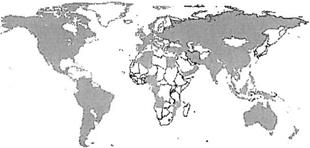
FGA professionals have extensive experience in the world's important hydrocarbon producing areas, including North and South America, the Middle East, Australia, New Zealand, Indonesia, Turkey, North Africa, Russia, China, Thailand, Myanmar, West Africa, India, the North Sea, Alaska, and Mexico.
The firm offers a complete range of geological and engineering services - from screening exploration prospects and designing development drilling projects to estimating reserves, forecasting future production, and presenting economic analyses. Major financial institutions accept the validity of our studies, particularly in the areas of reserve estimation and appraisal. The fair market value analysis technique developed by FGA is being applied by some of industry's largest players.
Major integrated and independent oil and gas companies have used our estimates of future production rates and available hydrocarbon resources to design facilities, and to establish contract terms.
FGA is a leader in the development and application of computers to the daily requirements of petroleum engineering. Mainframe programs, hand-held computer programs, and personal computer systems designed by Mr. Garb have been installed in many major integrated oil company offices around the world.
Associations with facilities design, seismic interpretation, petrology, and environmental firms, renowned in their own right, enable the FGA organization to offer a complete service to its clients under one master contract.
Because the company has no hydrocarbon production and because it has no outside ownership to dictate opinions, the determinations of the firm are independent. Its studies are without bias and are based on the best interpretation of all available data after processing wi th "state of the art" methods and equipment.
FGA restricts its activities exclusively to consultation; it does not accept contingent fees nor does it own operating interests in any oil, gas, or mineral properties. The firm subscribes to a code of professional conduct, and its employees actively support their related technical and professional societies.
The entire FGA staff is dedicated to providing each client with a personalized and cost efficient approach to serve their individual needs.
